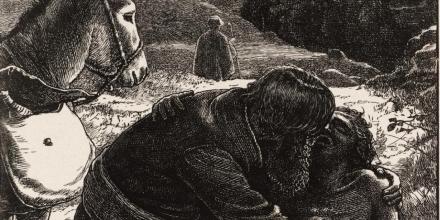
Detail from 'The Good Samaritan', Sir John Everett Millais, 1864.
‘The cluster of words describing those who are (or who are made to seem) different from us (whoever ‘us’ is)—the foreigner, the alien, the stranger—has been critical in the articulation of how we live after 9/11’.
So wrote David Simpson in the study from which we take our theme for 2017. The theme asks us to look at the way individuals and cultures have understood, represented, and dealt with strangers in their intellectual, linguistic, legal, cultural, and artistic traditions; the way the dialectic of the familiar and the foreign has become the very condition of understanding and organisation in the world we have created for ourselves to live in. The question of the stranger not only reaches back to the oldest human culture and earliest human imaginings, it also presents (arguably paradoxically) with a special urgency today, in the so-called ‘global’ age we currently inhabit. ‘Its ramifications are legal, ethical, and indeed comprehensively human’, writes Simpson: ‘who is welcomed and who is turned away? Who is a friend and who is an enemy? Who deserves the protection of the law and who is outside it? At what point does the working norm give way to the exception, and who gets to decide?’ Over the last 350 years, we have witnessed an Enlightenment project of cosmopolitan universalism that sought to overcome the conditioned estrangement of religion, race, gender, and country of origin by way of reason, science, or sympathy, break down in protracted war, cultural misunderstanding, ‘scientific’ racial stereotyping, and the birth of often aggressive forms of racism and nationalism. Indeed, it is precisely because we are everyday forging more and more global connections with peoples once geographically distant and culturally alienated that we need to engage with the question of the stranger as it continues to inform human thought and feeling and their critical and creative expression.
